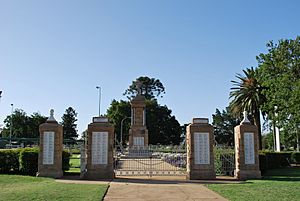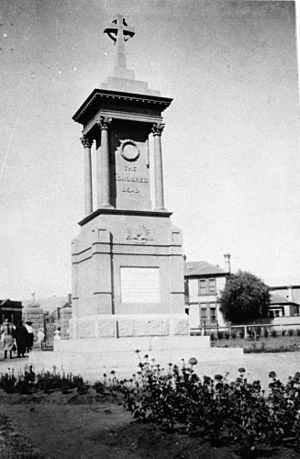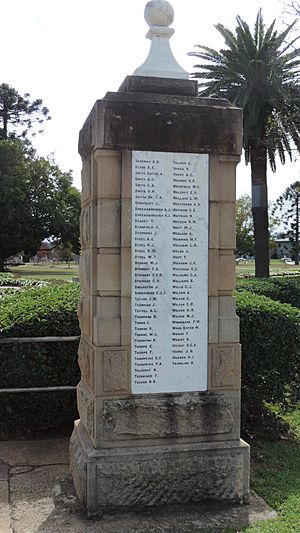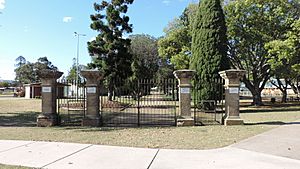Warwick War Memorial facts for kids
Quick facts for kids Warwick War Memorial |
|
|---|---|

Warwick War Memorial, 2008
|
|
| Location | Fitzroy Street, Warwick, Southern Downs Region, Queensland, Australia |
| Design period | 1919 - 1930s (interwar period) |
| Built | 1923 - 1924 |
| Official name: Warwick War Memorial and Gates | |
| Type | state heritage (landscape, built) |
| Designated | 21 October 1992 |
| Reference no. | 600946 |
| Significant period | 1923-, 1924- (social) 1923, 1924 (historical, fabric) |
| Significant components | memorial - gate/s, park / green space, memorial - war |
| Builders | F Williams and Company |
| Lua error in Module:Location_map at line 420: attempt to index field 'wikibase' (a nil value). | |
The Warwick War Memorial and Gates is a special heritage site located on Fitzroy Street in Warwick, Australia. It was built between 1923 and 1924. This important memorial was added to the Queensland Heritage Register on October 21, 1992. It stands as a lasting tribute to the brave soldiers from the Warwick area.
Contents
What is the Warwick War Memorial?
The Warwick War Memorial was built in 1923. Its grand gates were finished a year later in 1924. It is believed that Roy and Hugh Campbell designed this memorial. Frank Williams then built it.
The memorial honors 122 local men who died during World War I. The gates remember 377 local soldiers who served and came home. The memorial stands in Leslie Park. This park has been a public space for Warwick since the 1840s.
How Warwick's Park Became a Memorial Site
Warwick became an important town in the Darling Downs region in 1847. Early town plans in the 1840s set aside land for public parks. These areas are now known as Leslie Park and Cunningham Park.
Leslie Park, where the memorial is, was always meant for public use. Over the years, the local council worked to improve it. They added fences and gates to make it a nice place for people to visit.
In 1876, Walter Hill, who managed the Brisbane Botanic Gardens, visited the park. He suggested planting many trees. Many of these old trees and paths can still be seen in Leslie Park today.
Building the Memorial and Gates
The War Memorial's first stone was laid on June 7, 1923. The Prime Minister of Australia, Stanley Bruce, was there. The memorial was officially opened on December 5, 1923. The Governor of Queensland, Sir Matthew Nathan, unveiled it. About 3,000 people attended the ceremony.
The memorial was built to remember the Warwick men who fought for freedom. It cost £1445 and was made from Helidon sandstone. A well-known company, F Williams and Company of Ipswich, built it.
Roy Campbell, a returned soldier from Warwick, is said to have designed it. Some think his father, Hugh Campbell, might have helped too. The Governor was happy that a returned soldier was involved in the design.
The same designer and builder also created the Memorial Gates. These gates were put up one year later in 1924.
Other Memorials in Leslie Park
Over time, other memorials have been added to Leslie Park.
- Two stone markers (cairns) honor soldiers from World War II and other conflicts. These include wars in Vietnam, Korea, Borneo, and Malaya.
- Two old war guns are also on display.
- Other buildings like a lawn bowls club and a kindergarten have also been built in the park.
Why War Memorials Are Important
Before World War I, Australia had few public monuments. The memorials built after this war became our first national monuments. They show how much the war affected the young country. Australia lost 60,000 soldiers from a population of about 4 million. This was a huge loss.
These memorials were like sacred graves for soldiers whose bodies were buried overseas. The word "cenotaph" means "empty tomb."
Australian war memorials are special because they honor all who served, not just those who died. Australians were proud that their army was made of volunteers. These memorials show how communities supported the war effort. They also show the skills of local builders and artists.
Many World War I monuments have been updated to include later conflicts.
What Does the Warwick War Memorial Look Like?
The Warwick War Memorial is in the southeast corner of Leslie Park. It stands inside the Memorial Gates. These gates face the corner of Fitzroy and Palmerin Streets.
The memorial is a large structure made of Helidon sandstone and granite. It is about 35 feet (10.7 meters) tall. It has a base, a pedestal, and a Celtic cross on top. The sandstone pedestal sits on a granite base with steps. A special foundation stone is on one side.
The memorial's base has square pillars at the corners. These pillars have pyramid-shaped tops. This part of the memorial features AIF (Australian Imperial Force) badges. A marble plaque lists the 122 local soldiers who died in World War I.
Above this is a carved sandstone section. It has a carved wreath and the words "The Honoured Dead." Four polished granite columns with fancy tops support the top part. This top section has the dates "1914 - 1918" carved into it. A carved sandstone Celtic cross sits on top of the whole memorial.
The Memorial Gates
The gates have four rough sandstone pillars, each about 2.9 meters (9.5 feet) high. The two outer pillars have round marble tops. Marble plaques on the pillars list the names of those who fought in World War I and returned home.
Iron gates allow cars to pass through the middle. Smaller gates let people walk through on either side.
Leslie Park has entrances at each corner. Gravel paths cross the park diagonally from these entrances. In the middle of the park, where the paths meet, there is a rock and water feature. Large, old trees line the paths.
Another set of gates, called the Leslie Centenary Memorial Gates, are at the corner of Fitzroy and Guy Streets. These gates were moved from Glengallan Homestead. They celebrate 100 years since the Leslie brothers started their farm in 1840. These gates were designed to look similar to the War Memorial Gates.
Why is the Warwick War Memorial Important to Our Heritage?
The Warwick War Memorial and Gates were added to the Queensland Heritage Register in 1992. This means it is a very important historical site.
A Look at Queensland's History
War memorials show how Queensland's history has changed. They represent a time when many communities across the state honored soldiers. They also show the strong sense of Australian pride during and after World War I.
Leslie Park itself is important to Warwick's history. It was set aside as a public park when the town was first planned in the 1840s.
A Unique Part of Our Culture
This memorial is special because it is still in its original location. This is rare for such old memorials.
What Makes This Memorial Special?
The Warwick War Memorial and Gates show what a memorial from the 1920s looked like. They were built to be a lasting reminder of a major historical event. Their design and location help tell this story.
Its Beauty and Design
The memorial and its setting are a landmark in Warwick. They add to the beauty of the town. The memorial and gates are also admired for their excellent craftsmanship and design.
Connecting with the Community
The memorial is very important to the local community. It reminds them of a big historical event. It is also a central place for people to remember and honor those who served.
Special People Connected to the Memorial
The memorial is linked to the designers, Roy and Hugh Campbell. It is also connected to F Williams and Company, a well-known building company from Ipswich.
Images for kids





